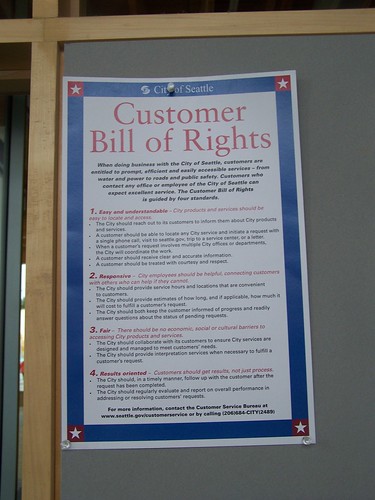Core values and WMATA: customer service and charging for services not received
In the recent reporting on WMATA's (Metrorail in the DC metropolitan area) revenue projections for the coming years and discussion about potentially raising fares, one of the revenue sources mentioned is from people who enter a station and then exit it within a short time, presumably without riding a train, the presumption being that service problems led them to change their mind about proceeding ("Could an Entry/Exit 'Grace Period' Boost Metro Customer Satisfaction," Washington City Paper.
The revenue from this is $2 million annually. And so the system is hesitant to change the programming for this type of "use" because they'd lose the revenue.
But making money off people who are dis-served, in fact not even served at all, is unethical.
A mission- and values-driven organization would not hesitate in making the right decision and stopping the practice.
This is the kind of behavior that would be protested were it from a prominent retailer.
Washingtonian Magazine doesn't agree ("Metro Shouldn't Reward People for Bailing on Trains.") It's discussion is focused on finances, and the fact that peer systems also charge people similarly for "bailing on a train."
Applying customer service principles to services provided by government agencies. From the standpoint of best in breed customer service, if you don't provide the service, you shouldn't get paid for it. But that doesn't mean its easy for governments to do, especially when typically service (and maintenance) functions are underfunded. See "How US state governments can improve customer service" and "Implementing a citizen-centric approach to delivering government services," both from McKinsey.
The past blog entry, "Level of Service and Level of Quality aren't just concepts from transportation planning," discusses locating "client" service centers for social services agencies far from where clients live.
This can be an issue with human and social services, medical and health care, and the timing and location of public meetings and hearings. In the 2009 round of proposing amendments to the city's Comprehensive Plan, I suggested reconceptualizing the Plan as the city's "business plan," although by statute it deals only with land use, by default it is the only "master plan" the city has, to include an element on citizen engagement. I didn't suggest metrics for service provision, but I did include discussion on holding meetings in accessible and central locations. It's worth exploring that concept further.

Seattle Customer Bill of Rights. In 2008, the City of Seattle created a "Customer Bill of Rights" to guide their approach to dealing with "customers." From the webpage:
Many City employees take great pride in providing excellent customer service. But over the years our system has become bureaucratic and unresponsive. We can always do better.There are four elements to their Bill of Rights, that services be easy and understandable; responsive; fair; and results-oriented.
In 2008, as part of our Customer Service Initiative, we adopted a Customer Bill of Rights that sets clear standards and expectations for our customers when conducting City business. Whether it's water and power, roads, or public safety, our customers are entitled to prompt, efficient and easily accessible service from the City of Seattle.
Charging for services not rendered is not "responsive," "fair," nor "results-oriented" but it is "easy and understandable," although for the service provider, not the customer.
Transit rider bill of rights. Apparently. a number of transit agencies have created customer charters such as Boston's MBTA Customer Bill of Rights. The Transportation Research Board aims to study the issue ("What does a "Customer Bill of Rights" mean for Transit Users and Transit Providers?").
Best practice resources. I looked at some of the articles on the topic in Governing Magazine, but they didn't really address the issue very well. Most were more focused on small pieces of the problem or digital communications elements of improving responsiveness by government agencies. While that's important, it's secondary to the primary point of being focused on providing excellent, quality service to customers of government agencies.
That's a point I made in this blog entry, "All the talk of e-government, digital government, and open source government is really about employing the design method," explaining that if a government isn't responsive at the most basic level, adopting digital communications strategies and focusing on "open data" misses the point.
I came across some interesting reports. In The road ahead for public service delivery, produced by PwC UK, they start off making a point I hadn't considered, that collectively government agencies are the biggest customer service providers of all.
The report, Re-Imagining Customer Service in Government (by GovLoop), outlines five principles for reshaping how government serves its customers:
- Design With the Customer In Mind
- View Customer Service in the Context of the Mission
- Share Resources Across the Agency
- Tie Customer Service to Open Government
- Consider Lessons Learned from the Private Sector
-- Best Practices in Transit, Seattle Urban Mobility Plan
-- Best Practices in Evaluating Transit Performance, Florida Department of Transportation
-- King County Metro Service Guidelines, Seattle
Labels: customer service, organizational behavior, provision of public services, public finance and spending, transit marketing




1 Comments:
Thank you for this insightful piece on the intersection of customer service principles and government agency operations. The use of AI tools for enhancing these interactions cannot be understated. AI platforms like VoiceSphere offer transformative capabilities for interactive document conversations through a user-friendly chat interface, presenting information in a context-specific and engaging manner. Websites like voicesphere.co demonstrate how seamlessly AI can integrate into service delivery, offering a personalized touch that aligns with the best practices you've highlighted. It would be fascinating to see your rich exploration of customer service principles expanded to include the possibilities AI tools bring to the public sector. Your readers would surely benefit from understanding how such technology could redefine citizen engagement and service satisfaction.
Post a Comment
<< Home